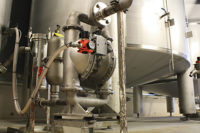Making the Case for Solventless Adhesives
Once a fringe player, solventless adhesives have become a workhorse in the laminating industry. Coim’s Dave Engel discusses how this happened and why solventless is such an attractive alternative to solvent-based adhesives.
In the not-so-distant past, solventless adhesives were reserved for only low-demand applications, such as candy bar wrappers, bottle labels and snack foods. But lately, solventless has become more than just a fringe option. Solventless adhesives are now considered by many to be the only way to go in virtually every application.
“Solventless has mainstreamed. Traditionally, you couldn’t use solventless in things that had foil in it,” says Dave Engel, Coim USA Technical Sales. “And now, with the improvement of solventless adhesives, you can get into foil applications, high-slip films, and high-barrier films where you couldn’t before. Applications where you need high heat or high chemical resistance are possible now.
“It can do just about whatever you need it to do. The technology is still being developed as far as optimizing it for retort and high-end demands for chemical resistance.”

Benefits of Solventless
While solventless adhesives have come a long way, are they really the workhorse of the industry? And what are the key advantages of solventless vs. solvent-based adhesives?
“There are a whole host of advantages,” says Engel. “Lower coat weight; there’s no solvent, so no emissions; no ovens; you can run at much higher speeds; less energy expended, etc. And for someone just entering the market, the capital investment costs are much less than with solvent-based laminators. In addition, the footprint is minor compared to a solvent-based laminator.”
But does solventless really offer all that a converter is looking for in a laminating adhesive?
“Definitely, solventless is the way to go,” says Engel. “There’s no question. Unless you’re doing something very specialized [like retort], in which case solventless probably isn’t the answer. But if you’re talking mainstream converting, it’s the way to go.”

The Case Against
But there are disadvantages to using solventless adhesives. According to Engel, one of the main things to consider is that there is no “green bond” with solventless.
“Green bond is where a [solvent-based] adhesive is dissolved in a resin, or vice versa, and has a much higher molecular weight,” he says. “So when you apply it to a primary substrate you pass it through an oven and you flash off the solvent, and the adhesive has inherent cohesive strengths, and has some tack to it as well, to adhere to that secondary web.
“In solventless, because you don’t have that solvent to bring the viscosity down, you have to start off with a much lower molecular weight,” Engel continues. “So there is no tack to it. You have to wait for the chemical reaction to occur to build that molecular weight and cohesive strength.
“Now the technology is being developed to accelerate that cure so that you’re getting that cohesive strength that much sooner. And that allows the converters to have a faster turnaround time than they did when solventless first came out on the market.”
He adds that if you have a solvent-based laminator, you cannot just convert it or retrofit it to run solventless. A converter must purchase a solventless laminator, so there are up-front capital costs; however, those costs are much lower that that of a traditional laminator.
Also, unseen costs are to be expected when working with a solventless adhesive.
“Someone working in solventless must work closely with their ink company,” says Engel. “When solventless first came out, there was a lot of trouble with ink smear or ink bleed because of incompatibility with the inks. But the ink companies have developed a system specifically for solventless. And the solventless adhesives, in turn, modify and work better with the inks.”
But some of those hidden costs have changed and even diminished as solventless technology has evolved.
“Another piece of equipment vital to solventless adhesive application is the M/M/D (Meter/Mix/Dispense) pump,” says Engel. “Solventless adhesives have a short pot life compared to solvent-based adhesive systems, on average anywhere from 15-45 minutes for solventless adhesives vs. 8-24 hours for solvent-based adhesives. The pump systems are used to deliver the adhesive to the laminator on demand.
“The two streams, adhesive and coreactants, are not combined until they come together in a static mixer tube about 12 inches long just before delivery. Different versions of these pumps include piston and gear designs.”
Early versions of solventless adhesives were often much higher in viscosity, especially one-component systems requiring moisture cure.
“The one-component systems were often used for paper/foil or paper/film applications,” says Engel. “Due to the higher viscosities, these systems were not pumpable at room temperature, and required heated pumps and hoses. Current technologies, except for some low-monomer TDI-based systems, are easily pumped and applied at room temperatures.”
Stand-Up Pouches
With the evolution of solventless adhesives come new uses and applications that open up new, very profitable markets, like stand-up pouches.
“That’s a great example of where solventless is today. Three or four years ago, solventless probably wouldn’t work in that application, but now it does,” says Engel. “The challenge in stand-up pouches is that bottom gusset - you need enough heat-resistance to seal that bottom. Now you can do it with solventless where you couldn’t do it before.
“The advantage of pouches is source reduction over a carton, and using solventless, the source reduction continues. You can do the same lamination with less coating weight. So, it continues that source reduction idea. No emissions, no odor issue, etc.”
Foil: Friend or Foe?
Based on all of this information, the only possible chink in the armor of the case for solventless adhesives would be a limitation in which substrates are candidates for use in solventless applications. It seems that only foil presents difficulty for solventless.
“I can’t think of a substrate that concerns me,” says Engel. “That’s one of the reasons that solventless is a lot more prevalent than it used to be. There aren’t really any substrates that cause us a whole lot of concern. It works with a lot of substrates. Foil is still a bit of a challenge - you have to do certain things to make foil work, but it can work.
“Part of that is just the handling of foil itself,” he says. “Tension control is of primary importance. You have to match the properties of the substrate that you’re laminating together, so you have to be careful.”
For more information, contact Coim USA Inc., phone (800) 345-8380 or visit www.coimgroup.com.
Reprinted from Flexible Packaging magazine.
Links
Looking for a reprint of this article?
From high-res PDFs to custom plaques, order your copy today!







